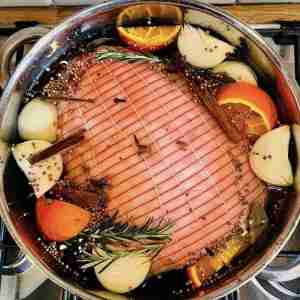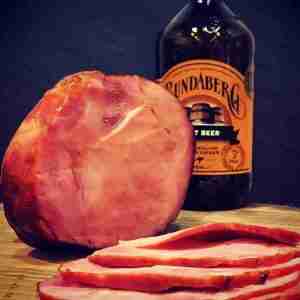Ham & Gammon
Explore our expertly prepared range of smoked and unsmoked gammon joints and cooked ham joints, cured to perfection for rich, traditional flavour.
-
Gammon Joints (Smoked & Unsmoked)
£23.95 – £54.95 Select options This product has multiple variants. The options may be chosen on the product page -
Wiltshire Cooked Hams – (2-2.5 or 4.5-5kg Joints)
£29.99 – £58.99 Select options This product has multiple variants. The options may be chosen on the product page
Why Buy Gammon and Ham from The Village Butchers?
Enjoy the unbeatable taste of our ham and gammon range, all expertly hand-picked premium cuts prepared by skilled butchers. Whether you’re planning a Sunday roast, a festive celebration, or simply stocking up on cold cuts, our ham and gammon options deliver on both quality and taste. If you’re looking for a centrepiece for a Sunday roast, try our rich and smoky maple & bourbon glazed gammon recipe or apple bourbon glazed ham recipe. For something different, try a recipe with a Caribbean twist, our jerk gammon recipe for adventurous cooks. With premium cuts and delicious recipe ideas ready to inspire, The Village Butchers helps you serve up something special every time.
Buy Gammon and Ham Online
For the highest quality ham and gammon, shop The Village Butchers. Ordering your favourite meats has never been easier, arriving directly to your door. Shopping at our butchers gives you ease and convenience whilst maintaining quality of fresh, tasty ham and gammon. Each cut is vacuum sealed for freshness, and our delivery ensures your order arrives in perfect condition. Discover why you should buy from an online butcher and experience the difference.
Ham and Gammon – FAQs:
How to cook a gammon joint?
When cooking a gammon joint, a classic method would be to simmer the gammon first, then finish it in the oven with a glaze for extra flavour and caramelised finish. Start by boiling the gammon for around 30 minutes per 450g in water or a mixture of water and apple juice or cider for added sweetness and bay leaves, peppercorns, onions, or cloves for aromatic depth.
Once boiled, partially cooked and removed from the pot, trim away the rind (leaving a layer of fat), then score it in a criss-cross pattern. Brush on your glaze of choice, such as honey mustard, maple, and bourbon, and place it in a preheated oven at 200 °C (180 °C fan/gas mark 6). Roast for about 20-30 minutes, basting occasionally, until the exterior is golden and sticky. Rest before carving to lock in juices and enjoy hot or cold.
What’s the difference between ham and gammon?
Ham and gammon come from the hind leg of a pig, but the difference lies in how they’re prepared and served. Gammon is a cured but raw joint which should be cooked by boiling, roasting, or a combination of both before eating. Once it’s cooked, it’s then referred to as ham. Ham is pre-cooked gammon and can be eaten hot or cold, sliced for sandwiches, served in salads, or as part of a roast dinner. Put simply, gammon becomes ham after cooking.
Can I freeze gammon?
Yes, both uncooked and cooked gammon can be safety frozen. Uncooked gammon joints can be frozen for up to 6 months, great for planning ahead for festival meals. Cooked gammon or ham can be frozen for 3 to 4 months, just make sure it’s fully cooled before freezing and stored in an airtight storage to prevent freezer burn. For the best results, always thaw gammon in the fridge overnight, once it’s defrosted, don’t refreeze. Consume after thawing to maintain the best texture and flavour.
How much gammon should I buy per person?
Typically, you should plan for around 200g of boneless gammon per person. For bone-in gammon, allow slightly more (roughly 113–150 g) per person to account for the weight of the bone. Following this guide helps to ensure hearty portions, with some leftovers for sandwiches, salads, or next-day meals. For large gatherings, consider sizing up slightly.
Is it safe to reheat gammon?
Yes, it’s perfectly safe to reheat cooked gammon (also known as ham), as long as it was stored properly and reheated thoroughly. Once cooked, gammon (which becomes ham) should be cooled within 2 hours and placed in the fridge, where it can be safely kept for up to 3-4 days.
When reheating, ensure the ham reaches an internal temperature of at least 75 °C to kill any potential bacteria. For food safety, never leave reheated gammon sitting out at room temperature, avoid reheating it more than once too, as this increases the risk of foodborne illness. By following these guidelines, you can safely enjoy leftover gammon without compromising on hygiene or health.
How do I reheat ham without drying it out?
When reheating ham, to keep it juicy and tender, it’s important to use gentle, low heat. Preheat your oven to around 160°C and place in an oven-safe dish. Cover tightly with foil to trap moisture and prevent the surface drying out. You could even add a small amount of water or stock to help create steam, which keeps the ham moist. Depending on size and thickness of the ham, heat it for 15 to 20 minutes per pound, or until it reaches an internal temperature of 75°C. Avoid overheating, as this can cause the ham to become tough and dry.




